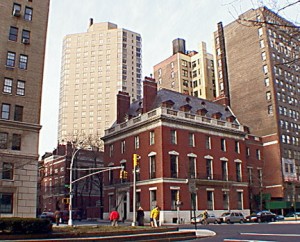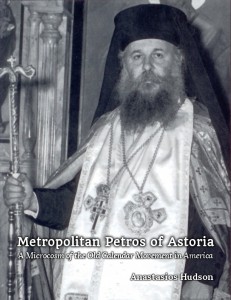Journey Into the Heart of ROCOR
Today I was talking to a historian friend on Facebook. He mentioned how he loves pouring over reams of historical data, something which bores other people to tears. I told him I share his passion. That sparked a memory of a most curious and interesting event that occurred during the writing of my thesis on Metropolitan Petros of Astoria: my journey into the heart of the Russian Orthodox Church Outside Russia (ROCOR).
While a seminarian at St. Vladimir’s Seminary in nearby Yonkers, New York, I became interested in the Greek Old Calendarists, much to the chagrin of some of my professors and fellow students (one fellow student, seeing an issue of Orthodox Tradition with my name on it in the mail room, dramatically exclaimed to me, “tell me this is not where your heart is!” while a professor walking by me in the library and seeing me reading the same remarked, “you don’t really believe that s*t, do you?!”) . After investing hundreds—if not thousands—of hours researching the Old Calendarists, I decided to do my thesis on Metropolitan Petros of Astoria, the first legitimate Greek Old Calendarist bishop in America, ordained by ROCOR bishops in 1962.
As part of my research for the thesis, I realized I would need access to the ROCOR Synodal Archives, where many documents pertaining to the ROCOR and its relations with the Greek Old Calendarists were kept. One of my fellow seminarians was a ROCOR monk who had recently returned from a monastery in Europe to continue his studies, and was given a blessing to attend St. Vladimir’s Seminary to do so. When not at the seminary, he resided at Holy Trinity Monastery in Jordanville, New York, where Metropolitan Laurus (+2008) lived as well. He spoke with the Metropolitan, who granted me permission to do research in the archives, located at the ROCOR Synodal headquarters.
ROCOR’s international headquarters, often colloquially referred to as simply “Synod,” is located at 75 E 93rd Street in New York City. This building is part of The George F. Baker Houses, an iconic family compound of houses right off of Park Avenue in Manhattan, and was acquired by the ROCOR Synod of Bishops in 1958. It houses the Cathedral of Our Lady of the Sign (which was formerly the mansion’s grand ballroom), administrative offices, a kitchen, an apartment for the resident bishop (at that time, Bishop Gabriel lived there), and many individual rooms, some of which are inhabited by people who work at Synod, such as the tireless musician, translator, and composer Isaac Lambertsen.
On the appointed day, I arrived at Synod to meet my monastic friend. An older gentleman manned the door, dressed in a suit and tie, reading a Russian newspaper, and occasionally answering the phone. The lobby was immaculately clean, although the lighting was dim—what would become a recurring theme. I announced who I was, and he phoned my friend, who promptly came downstairs and greeted me. He then proceeded to give me the tour.
Synod was sort of like something similar to Walt Disney World’s Haunted Mansion. It’s a huge building, half empty, with numerous winding hallways and staircases. But as one transects the numerous floors, instead of encountering ghosts doing various tasks as in Disney World, one instead would find various individuals quietly going about their business. Some were working, while others were sitting around conversing in low voices. If this were a Greek Orthodox operation, the noise level would be five times higher, and the various hangers-around would be more welcoming and animated, but as Synod is a fully Russian institution, the result was a rather low key experience where one had the distinct impression that people were at best indifferent and perhaps even mildly hostile to the presence of strangers.
In the kitchen, older women cooked, which is something that happens in all Orthodox institutions where there are kitchens. I recall being offered soup or something likewise hearty. My friend and handler then took me to a small door with a small pane of glass. Opening it, there was a bricked in wall. Visions of someone being bricked in as a medieval punishment came to mind, but a far more tame explanation was offered: the original owners were so rich, that they had their own subway stop for the workers to use daily, but as New York modernized and reorganized its subway system, such perks for the rich were gradually phased out, and the stop was bricked in. Adventurers would love to go into those abandoned tunnels, I’m sure.
Going to one of the upper levels, we sought out Isaac Lambertsen’s room to greet him. Isaac and I had communicated a few times by email, and have a mutual friend in common. As I recall, the hallways were not straight, but rather formed something akin to an L-curve or perhaps a V-curve. The hallways were again dimly lit, and I admit that were I living there, I would be afraid to walk those halls at night, for fear of whatever person might have made it past the old man guarding the door and then laying in wait in one of the many empty rooms! Well, now I am being dramatic—I am sure they have a security system Nevertheless, there is something romantic about walking around narrow, dark, dimly-lit hallways in a mansion in Manhattan off Park Avenue, and it’s a memory that will stay with me forever.
Finally, we arrived at the archives. At the time, Fr. Seraphim Gan was the archivist, and after the appropriate introductions, I was allowed access to the eight boxes on Old Calendarists. Boxes 1-7 were chronologically-organized, while box 8 was solely focused on one individual who has been in the center of some controversies in the history of the Old Calendarists. About half the material in that box was supportive, and the other half not-so-much.
Beyond the Old Calendarist materials, there was a filing cabinet labelled in Russian, “Their Graces in Schism,” which was locked. I was told it pertained to those bishops whom ROCOR considered to be schismatic at the time, such as Metropolitan Valentine of ROAC. Also, there were filing cabinets with archives from Synodal meetings. All of the earlier material was solely in Russian. My friend pulled out one document from the 1950s, where Bishop John (Maximovitch)—now St. John—voiced support for the Old Calendarists and ordaining bishops for them, but when I asked if I could copy said document, I recall being told it was, “outside the purview of my blessing” or something to that effect. Indeed.
We Americans do not have old castles or palaces. What we do have are old estates. Mt. Vernon, Monticello, and the like are all famous places where one can go and see a glimpse of life from a different age. ROCOR’s headquarters is also an estate; an urban estate and an oasis in the midst of the great hustle and bustle that is New York City. It clearly was in decline at the time I visited in 2005, but the people there had dignity nonetheless, and carried on their duties faithfully. I had mixed emotions about my visit: respect seeing a venerable religious institution; admiration of a work of American architecture; dismay at seeing the decline of what was probably once a vibrant community of co-laborers for the Gospel living in community; and a profound sadness that ROCOR would soon be reuniting with the Moscow Patriarchate, despite the serious reservations of many (for those who did not follow this course, see here). I was also grateful that I was able to see something that most people would never be able to see. Being a historian—even an amateur one—is something that opens up doors and contextualizes life.
I was able to copy several hundred pages of documents from the ROCOR archives, which formed the nucleus for my work on Metropolitan Petros. In the process, I had a lot of fun exploring this intriguing and mysterious place, as well.




Most excellent.
Great article Anastasios!
Thank you to your both!
I am curious as to why you were sad that ROCOR was reuniting with the Moscow Patriarchate. I think it has had a very beneficial effect.
Also, I wonder if you have run across an unpublished paper by Fr. George Lardas (who is fluent in both Greek and Russian) on the history of the Old Calendarists?
Dear Fr. John,
Thanks for commenting! If you remember me from Paradosis, you will recall that I am a Greek Old Calendarist, baptized at St. Markella’s Cathedral in 2006. I did my thesis on Metropolitan Petros, which has now been published as an eBook and in print-on-demand format. Please see the link at the right for more information.
In regards to Fr. George’s work, yes, I have a copy of it, and consulted it for my thesis.
In regards to my opinion regarding the MP/ROCOR reunion: as a Greek Old Calendarist/Genuine Orthodox Christian, I lament that the ROCOR under Metropolitan Laurus pursued reunion with the MP at the expense of its communion with its sister churches of Romania, Greece, and Bulgaria. I believe the reunion was premature, because of Ecumenism. My beliefs can be summed up in this official statement of ecclesiology.
I wish you all the best, and thank you again for commenting.
In Christ,
Anastasios